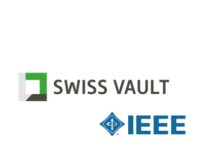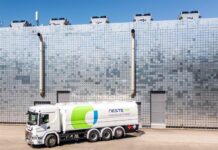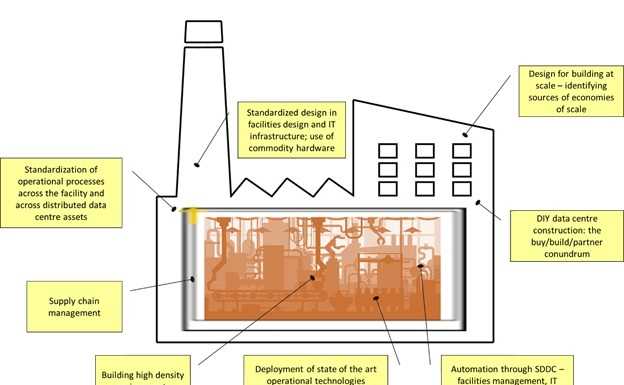If we needed more evidence of the criticality of data centre services, the COVID-19 pandemic has provided it. As governments, businesses, and individuals and have moved online, working and playing remotely to uphold public health guidelines, data centres have stepped up to deliver the IT services needed to support this massive shift in behaviour. For infrastructure providers, including the large cloud players, new pressure on capacity and service delivery demand is not likely to be short lived; while COVID has accelerated the digitization of collaboration and other processes, a return to pre-pandemic levels of digital activity is nostalgia that will not deliver the ubiquitous care, convenience and productivity that we are rapidly becoming accustomed to. But growing demand for data centre services brings with it potential for a more ominous outcome – carbon emissions associated with data centre operation to address additional requirements. At a time when the world is wrestling with the imperative to reduce GHG emissions to levels that would keep global temperature increases to 1.5 degrees C above pre-industrial levels, business as usual is no longer an option for the data centre industry.
Recognizing the criticality of environmental imperatives, data centre providers are now taking up the challenge, articulating sustainability strategies with a seriousness that has been missing from company agendas for some time. For many of these providers, sustainability just makes good sense – from risk management, business, and environmental perspectives. This alignment of economic and ecological opportunity – the “twin ecos” – is evident in the experience of OVHcloud, the French cloud services provider that now boasts 30 data centres across 4 continents, including a facility in Beauharnois, Quebec.
New DC Foresight report
 The relationship between business and environmental drivers of sustainability is also the subject of a new report from InsightaaS launched this week, OVHcloud: Sustainable by Design. The report draws on an extensive review of secondary literature on key issues in data centre sustainability management, providing industry context for a deep dive into OVHcloud’s environmental program development, activities and technologies. These issues include the broad-based call for better sustainability performance in the data centre industry from various stakeholders – including regulatory bodies, such as the EU which recommended zero carbon by 2030 in the 2019 Green Deal – and the ongoing debate around energy consumption by data centres. Are facilities in fact consuming more of the world’s electricity as they build infrastructure to address the data/app tsunami that demands ever more computing capacity and capability? And have data centre operators managed to deliver increasing levels of new compute, while improving the data centre’s environmental profile?
The relationship between business and environmental drivers of sustainability is also the subject of a new report from InsightaaS launched this week, OVHcloud: Sustainable by Design. The report draws on an extensive review of secondary literature on key issues in data centre sustainability management, providing industry context for a deep dive into OVHcloud’s environmental program development, activities and technologies. These issues include the broad-based call for better sustainability performance in the data centre industry from various stakeholders – including regulatory bodies, such as the EU which recommended zero carbon by 2030 in the 2019 Green Deal – and the ongoing debate around energy consumption by data centres. Are facilities in fact consuming more of the world’s electricity as they build infrastructure to address the data/app tsunami that demands ever more computing capacity and capability? And have data centre operators managed to deliver increasing levels of new compute, while improving the data centre’s environmental profile?
In the report, OVHcloud efforts to manage this seeming contradiction (more capacity, with less carbon) is outlined. With eight newly minted activity streams, the company has set an ambitious target – carbon neutrality by 2025 – which it intends to achieve through work towards six goals: define targets, improve efficiency to optimize WEC (water, energy, carbon) resource consumption, develop energy maturity through greater penetration of renewables, advance principles of circularity through server lifecycle assessment and reuse, leading to zero waste, use procurement to drive better carbon impact in the supply chain with a Sustainability Code for suppliers and improved packaging, and educate customers on their own ability to reduce energy consumption through creation of energy metrics that operate at the app or workload level. This last goal is indicative of the company’s progress on its sustainability journey; as key contributor to the report and Chief Industrial Officer at OVHcloud François Sterin explained, once you have achieved good PUE results, investments to move the efficiency needle farther forward offer decreasing benefit when compared with effort. Going forward, the company intends to continue to build operational efficiencies, but also to work though its supply chain, driving carbon improvements both upstream and downstream, in an approach that capitalizes on the whole data centre ecosystem to optimize performance. The report concludes with a discussion of metrics; an OVHcloud sampling are outlined in the figure below.
 InsightaaS launches Summer of Webinars series
InsightaaS launches Summer of Webinars series
The InsightaaS approach to researching and reporting on ICT innovation is community-based. IT experts have been organized into groups devoted to developing best practice positions on the adoption of advanced technologies, including cloud, IoT, analytics/AI, and data centre. IT expert-sourced research output from these groups is put to the test in broader networking sessions designed to socialize findings but also to add new perspectives to a specific technology question. The OVHcloud: Sustainable by Design report outlined above was conceived as one input to DC Foresight research activity that has grown up around GCDCS (The Great Canadian Data Centre Symposium), an annual data centre event cohosted by InsightaaS and McMaster University’s Computing Infrastructure Research Centre.
As have many organizations that rely on large public gatherings to share learnings, InsightaaS has transitioned its annual physical event in Hamilton, Ontario to a “Better than Live” version of the data centre conference, which will be held December 8-9th, and in a ‘cascade’ of leadup sessions to this main event. To build momentum for GCDCS20, and in response to an industry-wide need to find ways for IT professionals to stay connected and involved through this time of work-from-home and physical isolation, InsightaaS also launched a Summer of Webinars series, focused on specific data centre issues. In the fourth Webinar in this program, Sustainability by Design, InsightaaS has been privileged to work with professionals from across Europe and North America to create a dialogue that has connected us virtually, and that provided deep content on another critical challenge that we face today as we emerge from global pandemic – the need to think and act more sustainably about the delivery of IT services.
The series wraps with dialogue on sustainability
OVHcloud’s François Sterin opened the webinar session with a Spotlight presentation outlining “the how and why now” of data centre sustainability. Drawing on 15 years of experience working with different hyperscalers and European telcos, Sterin noted that electricity consumption in the data centre has long been an industry discussion. Today, however, a call to action and awareness is coming from analysts, customers, politicians/regulators, NGOs and the public. As it is invisible, the environmental impact of the data centre seems even more sinister than the factory with the large chimney stack, he added, and so is even more stressful for the public. Citing an IEA study, however, he concluded that “data centre energy consumption is not growing as quickly as consumption by the Internet.” While data demand is clearly growing, the industry is now able to handle more workloads, and advances in hardware silicon, combined with a massive move to cloud means data centre energy consumption has remained relatively flat. But the potential for continued improvement remains strong, he argued, and success can be achieved though a variety of techniques.
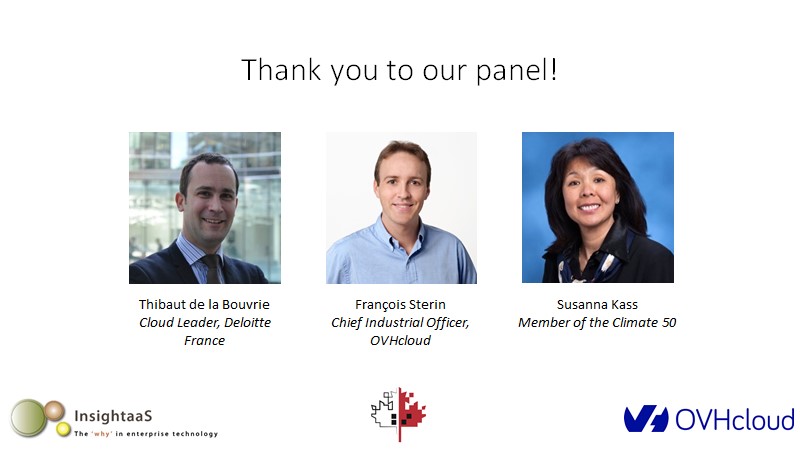
In a panel session which followed, Sterin joined Susanna Kass, energy fellow and lecturer at Stanford University, member of the Climate 50, and advisor to the UN on the achievement of SDGs in the data centre, and Thibaut de la Bouvrie, Cloud Leader at Deloitte France and head of the Deloitte France Digital Factory. These panelists provided a diverse perspective on business drivers, best practices, and success metrics in sustainability programming, which approximates the ecosystem view identified in Sterin’s presentation as vital to building forward momentum in data centre sustainability.
For example, while OVHcloud has adopted an ‘industrial model’ for operation marked by economy and frugality, which has also provided environmental benefits, Deloitte France was able to capitalize on this environmental innovation as it embarked on a massive shift to external cloud to support growing compute needs associated with its transition to a more solutions oriented/managed services approach. Deloitte’s option for OVHcloud’s ‘clean cloud’ was driven in large part, de la Bouvrie explained, by a culture shift towards sustainability demanded by the company’s young, professional developer workforce. According to Susana Kass, this focus on environmental outcomes, described by both cloud provider and customer, is part of a broader industry trend towards the alignment of data centre activity with the achievement of SDG or Global Goals, designed to protect prosperity while protecting the environment. Through her work with several large data centre operators, including eBay, HP, and Google, Kass has been involved in developing a range of activities – siting data centres in areas with abundant clean energy, minimizing water consumption in operation, recycling heat that is generated by the data centre, planning for responsible consumption and production, taking advantage of innovation in infrastructure build – and has observed a new level of commitment to sustainability promised by major operators at this time. According to Kass, pledges of carbon neutrality and carbon negative operation have been made by several large providers in 2020: Google has committed to carbon free matching 24/7 for every kilowatt per hour consumed at every site, while Microsoft and AWS have announced billion dollar investment funds to invest specifically in clean energy projects for data centre.
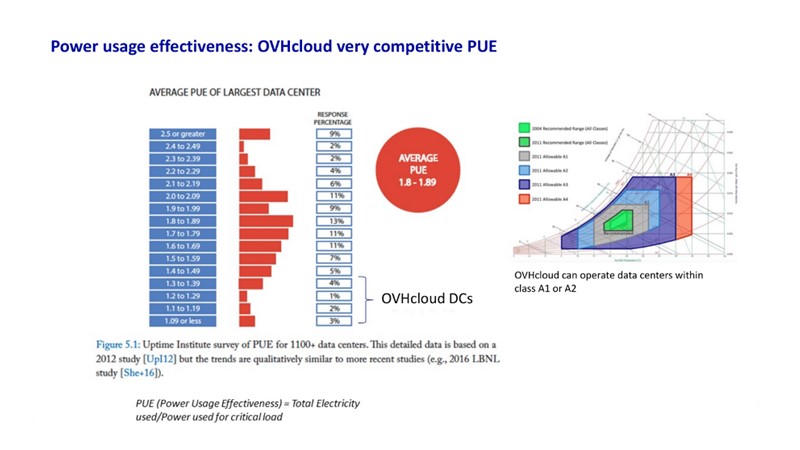 The bulk of the panel discussion was taken up with best practice examples – tactics and techniques designed to reduce data centre impact. As an operator with a proprietary closed loop water cooling system and circular, lifecycle assessment of standardized, company-built servers, Sterin shared OVHcloud’s competitive PUE and comprehensive carbon impact statement. Deloitte’s de la Bouvrie noted the significant impact data centre customers can have on reducing resource consumption by working with clients to strip out application features that are superfluous. Approximately 80 percent of software features are never used, he claimed, and their removal can improve energy consumption, as well as cyber security, where risk increases directly with the number of features that are introduced to a website or application. With proper architecture, however, and the use of code that is more efficient in terms of resource consumption, it is possible to make improvements on the energy bottom line; as de la Bouvrie pointed out, though the company has opted for a “zero data centre” strategy, it still owns resource consumption negotiated by its cloud provider. Kass, for her part, argued for the adoption of advanced techniques – affordable, hydrogen-gas fuel cell technology for energy storage, which delivers resiliency in addition to clean energy in situations where it is not possible to site the data centre close to sources of renewable energy.
The bulk of the panel discussion was taken up with best practice examples – tactics and techniques designed to reduce data centre impact. As an operator with a proprietary closed loop water cooling system and circular, lifecycle assessment of standardized, company-built servers, Sterin shared OVHcloud’s competitive PUE and comprehensive carbon impact statement. Deloitte’s de la Bouvrie noted the significant impact data centre customers can have on reducing resource consumption by working with clients to strip out application features that are superfluous. Approximately 80 percent of software features are never used, he claimed, and their removal can improve energy consumption, as well as cyber security, where risk increases directly with the number of features that are introduced to a website or application. With proper architecture, however, and the use of code that is more efficient in terms of resource consumption, it is possible to make improvements on the energy bottom line; as de la Bouvrie pointed out, though the company has opted for a “zero data centre” strategy, it still owns resource consumption negotiated by its cloud provider. Kass, for her part, argued for the adoption of advanced techniques – affordable, hydrogen-gas fuel cell technology for energy storage, which delivers resiliency in addition to clean energy in situations where it is not possible to site the data centre close to sources of renewable energy.
Something of the magnitude of eco and environmental saving that can be achieved through use of environmental technologies in the data centre was captured in a slide Kass presented in the panel discussion on metrics, which is reproduced below.

Ultimately, the net zero carbon business case that Kass has generated for immersion cooling contributes to a larger view of sustainability in the data centre that addresses energy, resilience, cost and social responsibility, that is measured by a new metric, the Sustainability Cost of Ownership. According to Kass, “In times like these, when Zoom has grown 400 times, or virtual meetings like Teams have gone to 4 billion meeting minutes per day, must have infrastructure that can immediately step up to support demand. Tactically, keeping the data centre up is key – but insufficient. We must rethink to also include our social responsibility and take action to give rise to net zero sustainable data centre design…. Data centres can be designed with no fossil fuels, no diesel generators, no CRAC units, no HVCA and still have high resilience,” and even provide resources back to the community.
For more detail on insights provided by the Sustainability by Design panel, Insight invites you to view a video recording of the webinar discussion here.
To access a copy of the OVHcloud: Sustainable by Design report, please click here.



